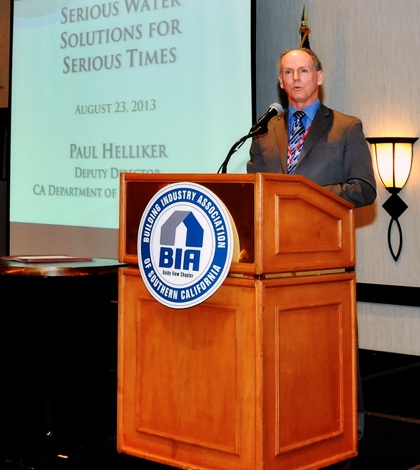Annual San Bernardino County Water Conference attracts a variety of officials, all of whom agree that water will be the premiere factor in determining future economic growth. Passing the state water bond next year would be a major boost.
In November of next year, California voters will decide the fate of an $11.1 billion water bond.
While no one is claiming that the measure will solve all of the state’s water problems, it should improve delivery from the Sacramento-San Joaquin River Delta and help bring much-needed restoration to that region, which provides much of California with water, according to local and state water officials.
“Water is arguably the most important issue facing the state of California today,” said Terry Kent, president of the Baldy View Chapter of the Building Industry Association of Southern California, which hosted the water conference. “Without water, we don’t have growth. It’s as simple as that.”
That makes passage of the water bond act – called by its supporters the Safe, Clean and Reliable Drinking Water Supply Act – especially important for the Inland Empire. The two-county region gets about 25 percent of its water from the 1,100-square-mile delta, also known as the California Delta, at the confluence of the Sacramento and San Joaquin rivers near Stockton.
“I don’t think $11 billion is probably enough until the next round of funding comes around,” said Paul Helliker, the state’s deputy director of delta and statewide water management. “But I would never say this is the last [water] bond issue the state is ever going to pass, if it does pass.”
Helliker was the keynote speaker at the seventh annual San Bernardino County Water Conference, held recently in Ontario. Like most of the officials who addressed the crowd of more than 300 at the Doubletree Hotel, Helliker presented a somewhat optimistic picture of the state’s water infrastructure and delivery system.
“We do have a lot of resources at our disposal, but there are some major challenges, especially regarding the delta,” Helliker said. “A major earthquake in that area could be a disaster for the entire state. We need to do something about that, along with improving the delivery system.”
Unlike similar gatherings in the past, this year’s water conference attracted a number of people from the real estate industry.
That so many real estate agents, both commercial and residential, attended the conference was encouraging, according to Helliker.
“I was very pleased to see that,” Helliker said. “It’s nice to see that a lot of real estate people aren’t taking water for granted anymore. They’re starting to understand that they can’t build houses unless they have an adequate water supply where they plan to build. The state now has strict guidelines about how much water you have to have if you’re going to build houses, with a lot of connection fees.”
Despite their importance, water issues can be a difficult issue with which to engage the public, Helliker said.
“Water is something that people take for granted,” Helliker said. “It’s not something tangible, like sitting in freeway traffic every day. If they turn on the faucet and water comes out, then there isn’t an issue. They don’t even think about where that water comes from.”
But it was the water bond that will appear on November ballot next year that received much of the attention during the conference, including a special study session dedicated exclusively to it, with some background information included on the proposed Bay Delta Conservation Plan.
The bond was put together in 2009 by then Gov. Schwarzenegger and state lawmakers. Its intent was to ensure an adequate water supply for future generations, according to the Association of California Water Agencies.
The measure was originally supposed to appear on the 2010 and 2012 ballots, but was removed both times because of the recession. In both instances, officials wondered whether, if the measure were to be approved, the state could afford to borrow that much money during a bad economy.
Now, with the state’s economy somewhat on the mend, the water bond will finally appear on the ballot. If it passes, the state would be allowed to borrow $11.1 billion for a series of water projects throughout the state.
Some legislators in Sacramento who are still skittish about the economy have proposed reducing the bond to $5 billion or $6 billion, but given California’s urgent water needs that’s not likely to happen, said Joe Grindstaff, general manager of the Inland Empire Utilities Agency, a municipal water district that covers most of the Inland region’s east end.
“I don’t think that $5 billion would be nearly enough to solve the state’s water needs,” said Grindstaff, who led one of the water conference’s study sessions. “That might be enough for a few short-term solutions, but it wouldn’t do much more than that.”
The water bond would allocate about $4 billion for development of local resources, another $4 billion the restoration of various ecosystems throughout the state and $3 billion for surface and groundwater storage projects, according to the Association of California Water Agencies.
Broken down, the water bond would help pay for several projects, including $1.4 billion for regional water management projects, $1 billion for water protection and cleanup and $1.25 billion for water recycling and advanced treatment.
Every dollar authorized by the bond would leverage $3 to $4 in other funds, for a total of nearly $40 billion, according to the agency, a statewide coalition of public water agencies with more than 440 members.
Even $11 billion might not be enough to solve all of the water problems in a state as large as California, said State Sen. Bill Emmerson, R-Redlands.
“I have my doubts that this bond is big enough, but there’s no question that we have to get this passed,” Emmerson said. “Any state that wants to spend billions on high-speed rail can afford $11 billion to fix its water system.”
California’s water problems are hurting growth in the state, perhaps even in the all-important housing market, said Steve Johnson, director of the Riverside office of Metrostudy, a housing database used for research by government agencies throughout the United States.
“California is still attractive to a lot of people, but at the same time it’s still struggling,” Johnson told the gathering. “The state’s demographics are changing, and it doesn’t attract people like it once did, although I still think the state’s economy is coming back.”
The local housing market, however, is another matter.
Despite some solid sales and median-price figures recently for single-family homes in the Inland Empire, the two-county region’s housing market is not in the middle of a major comeback, according to Johnson.
“I think what we’re seeing now in the housing market is more of a correction in the coastal communities,” Johnson said. “The market is getting a lot better in Los Angeles and San Diego counties, but I don’t think it’s helping the Inland Empire that much. The Inland Empire is just doing OK right now.”
Photo by Reay Design Studio.
 IE Business Daily Business news for the Inland Empire.
IE Business Daily Business news for the Inland Empire.


